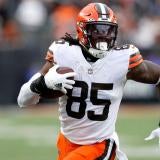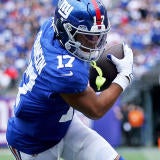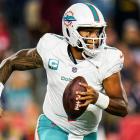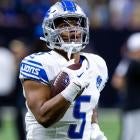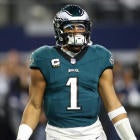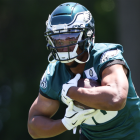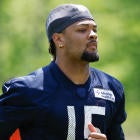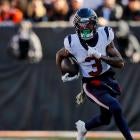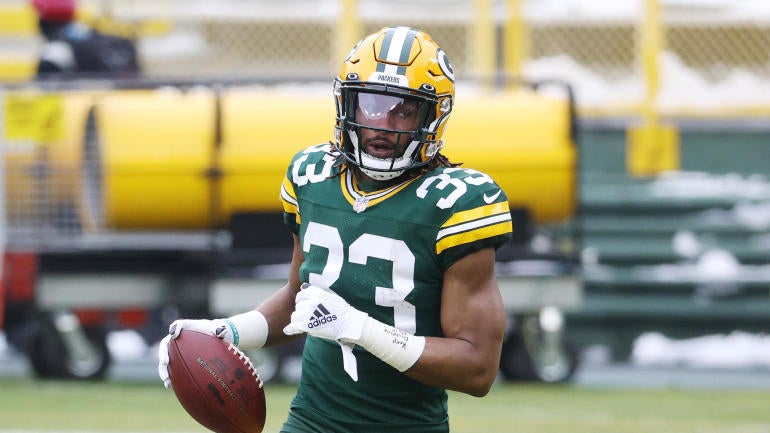
When it comes to setting a Fantasy Football lineup, the matchups are really important. Okay fine, maybe not for the stud players who rack up stats each week -- they're starting no matter who they play. But there aren't a lot of those guys. It's the non-obvious guys who we all must make decisions on during the season.
This is my attempt to make some of those decisions now. Before Week 1, before the preseason, and before I even draft a single player.
Every year, I revert to the dark side of Fantasy Football and study every defense. I lean heavily on data such as yards after catch or contact, missed tackles, allowed rush and pass attempts, catch rates, defensive ADOT (or DADOT), blitz and pressure rates and also offensive success rates. But I also evaluate who each team added, who they parted ways with, and how good their starters and bench guys actually are.
When I'm done, I have a grade from 1 to 10 on:
- every team's pass rush
- every team's pass coverage
- every team's run defense
For running backs, I go a step further and also create a grade for:
- every teams' pass coverage against running backs (predominantly linebackers and safeties)
This way there were two specific grades to use for running backs, but the primary one was obviously the run defense. That made up 90% of the final grade, with the running back-focused pass coverage making up the final 10%. Once that math was done, a cumulative grade was created.
I took this grade for each defensive unit and plugged it into each offense's schedule. Each of 17 matchups for every NFL offense now had a grade. I added those grades together to give an informed projection on which teams have easy schedules, and which ones have hard schedules.
Once you get a look at the schedules, you'll see the biggest winners and losers based on who they'll play, and in a few specific cases, when they play them.
How each defense graded out
Here are the final grades for every defense used in the Running Back Projected Strength of Schedule Rankings (PSoS), with the toughest defense ranked first:
| Team | Grade | Team | Grade |
| PIT | 10 | GB | 5.9 |
| TB | 9.8 | NYG | 5.9 |
| LAR | 9 | BUF | 5.1 |
| WAS | 9 | KC | 5 |
| NO | 8.9 | MIA | 4.9 |
| IND | 8.8 | LAC | 4.2 |
| CLE | 7.9 | DAL | 4.1 |
| SF | 7.9 | TEN | 3.8 |
| CHI | 7.8 | CAR | 3.1 |
| BAL | 7.1 | JAC | 3 |
| MIN | 7 | NYJ | 2.8 |
| SEA | 6.8 | ATL | 2.1 |
| ARI | 6.6 | CIN | 2.1 |
| NE | 6.1 | LV | 2 |
| DEN | 6 | HOU | 1.9 |
| PHI | 6 | DET | 1.1 |
What the running backs are up against
Here are the Projected Defensive Matchup Rankings for every team for Weeks 1 through 17 (Week 18 isn't included; easiest projected schedule No. 1 -- i.e. Denver):
| Rank | Team | Rank | Team |
| 1 | DEN | 17 | LAC |
| 2 | NE | 18 | CAR |
| 2 | MIA | 19 | BAL |
| 4 | JAC | 20 | HOU |
| 5 | PIT | 21 | NYG |
| 6 | IND | 22 | TB |
| 7 | NYJ | 23 | CIN |
| 8 | WAS | 24 | ARI |
| 9 | SF | 25 | CHI |
| 9 | KC | 26 | DAL |
| 11 | PHI | 27 | LAR |
| 12 | NO | 28 | TEN |
| 13 | CLE | 29 | LV |
| 14 | BUF | 30 | DET |
| 15 | ATL | 31 | SEA |
| 15 | MIN | 32 | GB |
Biggest Winners
Najee Harris: The Steelers landed a top-5 PSoS, which in and of itself is stunning since they've got the Ravens and Browns twice each in their future. But three of those four challenges won't happen until Week 13, which means Harris has plenty of time to gather experience and stats whilst punishing defenses. A recap: he's got a very good schedule, he figures to get a big workload, he's got a heck of a pedigree and the team wants to run the ball more effectively this year. Other than the offensive line, which is admittedly a pretty big deal, it's becoming really, really hard to find reasons to not want Harris on your Fantasy team. I'm ready to take Harris with a late first-/early second-round pick.
Antonio Gibson: Washington has a lot of choices when it comes to running the football, but the one they used the most and should continue leaning on in 2021, is Gibson. When they do, he'll see a top-10 PSoS that's boosted by not-tough-enough matchups along the NFC East. There is a four-week stretch beginning in Week 7 that is broken-mirror ugly, but before and after that, Gibson should have the chance to be a big-time Fantasy factor. It's enough to lock him in as a top-15 Fantasy rusher and a second-round pick.
Myles Gaskin: This guy's offseason has been nothing short of stupendous. After the Dolphins added only backup Malcolm Brown and seventh-round pick Gerrid Doaks, the squad finds themselves tied for the second-best PSoS in the league. Gaskin, 24, has a legitimate shot to lead Miami's run game for however long he stays healthy for against a docket that gets soft after September. He's a Round 5 pick who could ascend to Round 4 by August.
James Robinson: We're drafting Etienne ahead of Robinson, but it's not like Robinson is a non-factor. If the Jaguars stick with him as their "thunder" to Etienne's "lightning," then he should fare well against a favorable group of opponents. He'll just be more touchdown-dependent than he was last year, and that easier schedule helps. Round 7 is an acceptable time to draft him as a possible flex in non- and half-PPR.
Melvin Gordon, Javonte Williams: Look, Gordon has three selling points: He's a running back with a pulse, he should see the lead role for Denver to begin the season, and his schedule is not only good all year long but especially in Weeks 2 and 3 (Week 1 against the Giants isn't horrible). Williams' selling points involve his physical style and an eventual rise to being the Broncos' top back, but that's not promised to happen in the early going. At least Williams' first season won't be bogged down by tough opponents. I guess it's more responsible to take Gordon first, but both are worth Round 7 picks.
Biggest losers
Aaron Jones -- maybe: Having the absolute worst PSoS is not good, and oy vey, look at his schedule from Week 11 on. But for comparison's sake, the Packers had the 10th-worst PSoS last year and Jones was excellent, albeit with Aaron Rodgers as his quarterback. There's the rub. If the Packers actually don't have Rodgers then Jones will be left as a sitting duck in an obviously downgraded offense with the toughest projected schedule and a bully back in A.J. Dillon potentially swiping high-value touches from him inside the 5-yard line. His Fantasy value will go into a free fall if Rodgers moves on. Let's hope it doesn't happen.
Chris Carson: Seattle seems hell-bent on running the ball for some reason, but they'll be doing so against the second-toughest PSoS. Only one of Carson's first seven matchups is a peach (Tennessee, Week 2), and there's already a sense that he may continue sharing touches after playing over 60% of the snaps in just three 2020 games. Your best move might be to resist drafting Carson and trade for him if he struggles through October.
Josh Jacobs: First an offensive line exodus, then Kenyan Drake arrived, and now Jacobs is staring down the barrel of the Ravens and Steelers in Weeks 1 and 2 with a bunch of tough outings coming soon after. We're running out of reasons why we'd want to draft Jacobs. Hopefully, someone takes him before you'd consider doing so in Round 4 or 5.
David Montgomery: This is more of a warning than a blanket loser statement for Montgomery. Last year, the Bears had the fourth-best PSoS. Montgomery especially benefitted once he got to November and December when the opponents became weak. There isn't such a case this year -- Chicago is saddled with the eighth-worst PSoS, plus Tarik Cohen is expected to recover from a torn ACL. Montgomery is still a good No. 2 Fantasy running back, but don't expect him to come anything close to what he did in 2020. Bank on him as a top-40 pick.


